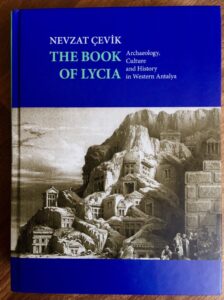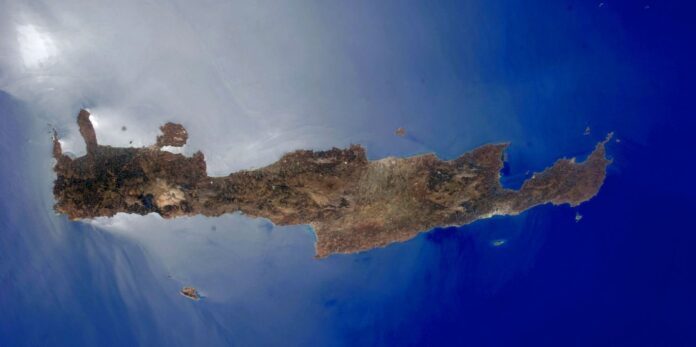………………………………………………………
Lycia
Crete, the Aegean Islands, and Mainland Greece
Minoan Crete
Pelasgians
Homer
The Hattians, the Louvites, the Hurrians
…………………………………………………………………………
Lycia
Lycia is situated at the south-western tip of Anatolia, to the south of Caria. The Hellenes gave it this name at the time of Homer. It is thought that its people were those referred to as “Lukka” in the Hittite documents and that they were probably influenced by the Luvians. Homer wrote that they were descended from a Hellene, Glaukos, and a Lycian princess, so as to be able in part to attribute the oriğin of the Lycians to the Hellenes. Herodotus himself states that the Lycians were the result of a fusion of an indigenous population with Cretan immigrants brought there by Sarpedon, and regards this version of their origin as a tradition inherited from Crete and Caria.
Ephorus, the author (in the fourth century BC) of the first universal history, states also that the immigrant Cretans, after having founded Miletus in Caria, spread towards the interior and the south of Anatolia. It is possible that Herodotus, who was interested in the relationship of the Lycians with Crete, allowed himself to be influenced by Cretan emigrants of his own time.

Herodotus asserts that the Carians came from the islands into Anatolia, and refers to the Cretans. On the other hand, he states that the Carians themselves claimed to be indigenous. It is quite clear, though, that there was a close relationship between Caria, Crete, and the islands.
It is more probable that things happened the other way round and that it was Crete which was influenced by Anatolian emigrants. The Lycian language, which has not yet been deciphered, would also have been an indigenous language, not Indo-European. Philologists are generally in agreement on the Anatolian origin of this language, from which Greek later borrowed part of its vocabulary.
Crete, the Aegean Islands, and Mainland Greece
Neolithic civilization in central Anatolia (Çatal Höyük, Hacilar) underwent a significant evolution between 7000 and 6000 BC. Then about 4000 BC the Sumerians created a civilization of considerable refinement in Mesopotamia. We know that the Hattians were in Anatolia between 3000 and 2000 BC, with the Hurrians to the east.
There was therefore a flowering of civilization along the Mesopotamia/Anatolia axis which progressed slowly towards the west.f
Until 2000 BC the different Anatolian cultures, upon which the Luvians and the Hittites would draw, were the creation of indigenous non-Indo-European peoples, namely the Hattians and the Hurrians.
By 2600 BC Anatolia was well into the Bronze Age. It is generally agreed that it was at about this time that its inhabitants took to the sea, and invaded in successive waves the Cyclades, Crete, Thessaly, and the rest of Greece, eventually spreading all round the Mediterranean basin, and even into Egypt.
These Anatolian invaders brought with them the art of cultivating the vine and the olive tree, the plough, an advanced architecture, a glazed pottery, the metallurgy of bronze, and, finally, the cult of the Mother-Goddess. They spoke a language different from Greek, which was then still unknown on the shores of the Aegean. The names of the oldest places and cities in Crete and in the Peloponnese belong to this pre-Greek language, traces of which are also found in Anatolia, in the Aegean islands, and in Italy. Philologists are generally in agreement on the Anatolian origin of this language, from which Greek later borrowed part of its vocabulary.
Minoan Crete
We observe a particular enthusiasm among West Europeans about the sources of their civilization. Each new discovery has led them to find a yet earlier date for their point of departure in history. Nowadays we see attempts being made to move this point of departure from Mesopotamia the Neolithic Anatolia. In the early nineteenth century Western cultural roots were considered to be found in Greece, and Greece only, but as the important influence of Minoan Crete over the Aegean basin became better understood, the claim was later made that it was the Minoans who formed the basis of Western civilization.
However, the Minoan civilization in Crete, one of the most remarkable cultures of antiquity, was created by Anatolians. Between 2200 and 1750 BC, which was the middle Minoan period, the first palaces were built, and numerous advances in technology and the arts were achieved. An early hieroglyphic writing came into use in the eastern basin of the Mediterranean.
Between 1750 and 1580 BC towns razed by an earth-quake were rebuilt. Colonnades appeared, as did the art of fresco-painting and a new writing, Linear A. Minoan colonies were formed on nearby islands, and trading posts were maintained on distant Cyprus and at old Ugarit on the coast of Syria. The sacred symbols of the bull and the double axe (of Anatolian origin) were extensively revered in the Aegean during this period.
After a further earthquake in 1580 BC, the Minoans began to spread their civilization to the Peloponnese. Until then, little of any significance had been happening in Greece. It was not until about 1600 BC that the first wave of Indo-Europeans, the Achaeans, invaded from the north and created a new centre of civilization at Mycenae, on the plain of Argos, and remained under the Cretan thalas-socracy.
It is clear that towards 1400 BC the Mycenaeans, having become rivals of the Cretans, conquered them and occupied their island: their last writing, Linear B, is in Greek. It is possible that they burned Knossos, the Cretan capital. In any case, the Mycenaeans became the sole power in the Peloponnese. These were the people whom the Hittites of the fourteenth century BC called the Ahhiyawa and whom the Iliad designates as the Achaeans.
Their expedition against Troy probably marks the zenith of their expansion. A little later, towards 1200 BC, they were in their turn overwhelmed by new invasions of Hellenes coming from the north-the Dorians. The basic difference between the Minoans and the Mycenaeans is that the former left little evidence of violence in their art, while the latter took it as a major theme. Add to that an oral history of death and devastation passed down through Homer, and a people emerge forever girded for baitle. The Mycenaean Empire crumbled after the Trojan war, and three centuries of dark ages bury Greece‘s heroic age in myth.
Pelasgians
The Hellenes of the classical period were the first to designate as Pelasgi or Seafarers those who were already living in the region when they arrived, and who had come there by sea. These people probably did not use the name for themselves, though modern historians have continued to refer to them by this title. The Pelasgians, described as being of medium height, brown-haired and swarthy, were neither Semites nor Indo-Europeans. They are generally considered, in spite of their heterogeneity, to be ‘Mediterranean race’.
It is also accepted that the Pelasgians were mainly Anatolians who, while keeping Anatolia as their base, were the first civilizers of all the lands of the Aegean basin, including the islands, Crete, and the rest of Greece. This fact enables us to understand the close relationship of Crete and the Peloponnese with the Aegean shores of Anatolia, with Troy to the north and Miletus to the south.
It is known, for example, that Miletus was founded by the Minoans of Crete, who had returned to their Anatolian ancestral cradle. Further, it is evident that the Mycenaeans and the Pelasgians/Minoans merged, as did the Hittites with the Hattians. If one refers to Herodotus, who defines the Athenians as ‘Pelasgians who learned the new language (Greek) one can understand more fully the significance of their expansion. Unlike their Babylonian and Egyptian contemporaries, the Minoans left little written history – and the writing they did leave is largely indecipherable. Herodotus also states that the Hellenes took their gods from this people.
Political liberties and rights first evolved at Miletus, and this city served as a kind of experimental laboratory for their development. The freedom of man was not a deliberate choice but a natural consequence of this process, before the initiation of which words such as individual, self, and ego; had not previously existed in the language. The lonians hated war, just as the people of Catalhoyuk, Minoan Crete, and Troy, on whom war had been imposed, had done. This was in contrast to the Mycenaeans (Achaeans), militarist Sparta, and imperial Athens. The situation in the Aegean region at that time can be likened to that in Italy at the beginning of the Renaissance when towns formed themselves into states after the Papacy and the Empire had been mutually weakened by long conflict.
Homer
The lonians had at their disposal the cultures inherited from Mesopotamia-Sumerian, Babylonian, and Assyrian – the Anatolian cultures of the Hattians/Hittites, Hurrians, and others and, further to the south, that of Crete. Therefore, culturally, Homer turned eastward to Anatolia and Mesopotamia, and southward to Crete, whose civilization had strong Anatolian traits, in order to create his saga.
In such a context Homer can equally be considered as the precursor of the Ionian Physicists who came later; they also were resolutely Anatolian. The hypothesis that the lonians went to Attica from Anatolia, as some have suggested, could perhaps be a better explanation of the enigma of Homer.
Comparison of Anatolian poets and philosophers with those of Greece between 900 and 500 BC shows clearly that the appearance of Homer in Anatolia did not happen by chance. To say this should not, of course, be construed as an attempt to deprive the Greeks of their cultural heritage, but rather to stress the contribution of Anatolia, our country, to Greek civilization.
During three centuries, Asia Minor-particularly Ionia and the islands-gave to the world a group of seven poets each of whom was the initiator of a genre: Archilockus of Paros; Alcman, born in Sardis in Lydia; Terpander of Lesbos; Alcaeus of Mytilene; Sappho, a contemporary and compatriot of Alcaeus of Mytilene, perhaps the greatest poetess; Mimnermus of Colophon, and Thaletas of Crete.
In the Iliad. Homer allows us to perceive, beneath the generous impartiality of the poet, a penchant in favour of the Trojans, who showed great respect for women, had close and affectionate family ties, acted in war collectively rather than individually, and resigned themselves to ill-fate with dignity. He ranges on their side not only Aphrodite but also the two Anatolian gods, Apollo and his sister Artemis.
Homer’s descriptions show the poet’s deep love for the Aegean shores of Anatolia, as well as a nostalgic attachment to Minoan Crete. He depicts the Achaeans as rather coarse, vindictive, and cruel, as Toynbee does when he calls them ‘post-Minoan barbarian war-lords’. As to the gods, supposedly subject to the same passions as human beings, they form a boisterous and lustful troop, whom Homer at times gives the impression of not taking seriously. He seems more in favour of the Anatolian rites of collective feasting than the human and animal sacrifices of the Achaeans.
Most commentators accept Homer as the poet who gave form to traditional epic poems telling of battles already four centuries old. It is known that after three centuries, during which the Iliad and the Odyssey were handed down orally, a commission was set up by Pisistratus, tyrant of Athens, or more probably by his son Hipparchus in the sixth century BC, charged with establishing the authentic text and putting it into writing. All the versions that we possess contain numerous obscurities, repetitions, differences, interpolations, etc.
The Hattians, the Louvites, the Hurrians
First known inhabitants – the Hattians, the Louvites, the Hurrians. As far as we know, the Hattians (3000BC) were the first distinct race of people to live in Anatolia. They left us no written testimony, and our knowledge of the Hattian language comes to us from Hittite or Assyrian sources. According to the indications these provide, Hattian was an indigenous language, different from all other known languages.
From its language, its religion, and its art, the Hattian civilization appears to have been one of the most advanced of its time, because the whole of Anatolia was named Hatti. The Hittites, successors of the Hattis, were to inherit their capital, Hattusas, and numerous linguistic and cultural legacies. Before the coming of the Hittites, another civilizing population appeared in the south-west of the peninsula.
These people were known as the Luvians, and they lived side by side with the Hattians. If certain hieroglyphic texts found at Hattusas are indeed in Luvian, it can be claimed that their language was Indo-European, belonging, like Hittite, to the Anatolian group.
Place names deriving from Luvian are encountered not only in Anatolia, but in Crete, the Aegean islands, mainland Greece, and as far away as Italy, Sicily and the Balkans.
Thus, long before the Hellenes, the Luvians appear as the first invaders who, by their influence on the indigenous populations of Anatolia, may have stimulated the flowering of a new culture. Around 2000 BC, the east and the south-east of Anatolia were occupied by the Hurrians, who were neither Indo-Europeans nor Semites. Their civilisation reached its peak about 1700 BC, at which period Aryan warriors established a State called Mitanni. They maintained and radiated the Sumeric-Babylonian cultural heritage for much longer than they kept their political independence. Their language, which was agglutinative, does not fall into any known group. Their principal influence on the Hittites was in transmitting to them some of their religious beliefs. The Hurrian mythology influenced Hesiod and Homer through the late Hittites and the Phoenicians. The Gilgamesh epic, which was found in Hattusha, is a Hurrian interpretation.
The Hittite Empire ultimately encompassed all the population groups of Anatolia, and represented ane of the first civilized societies of its time. It was organized as a confederation, a structure which enabled it first to establish, and then to maintain for eight centuries, the unity of Anatolia, and to protect it from barbarian invasion. In fact, the usual waves of invasions were absent during the Hittite period. It was during this time, therefore, that the territory first appeared as a geopolitical unity on the world scene. For the first time political unity was superimposed on the geographical unity of the peninsula, creating in people’s minds the idea of belonging to Anatolia. I see in this an essential contribution by the Hittites to the history of Anatolia-the establishment and maintenance of its territorial unity.
The influence of the Hittite deities on the Greek gods is quite clear. It was in Crete and Anatolia that the anthropomorphic development of the gods reached its conclusions. The cult of the Mother-Goddess, with a dying and resurrected god as consort and son, is very important inCrete. This cult, which was born in Anatolia, spread throughout the Middle East and the West right up until the corning of Christianity. Like so many things Minoan, the cult of the bull symbol -representing strength and fertility – probably came originally from the East. This ‘East’ implies Anatolia more particularly Neolithic Çatalhöyük, for sanctuaries in Cretan palaces, like those in Çatalhöyük, have bull-horns everywhere frescoes display bulls, and the doors of burial places are filled in with bull skulls.
Source: Turgut Özal, Turkey in Europe, Europe in Turkey






















